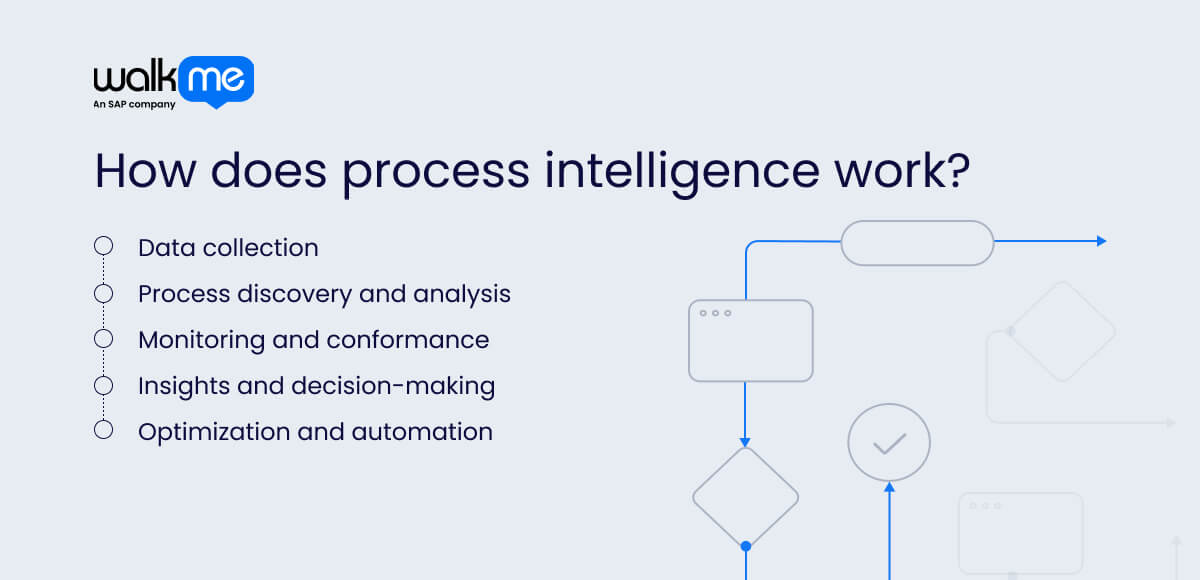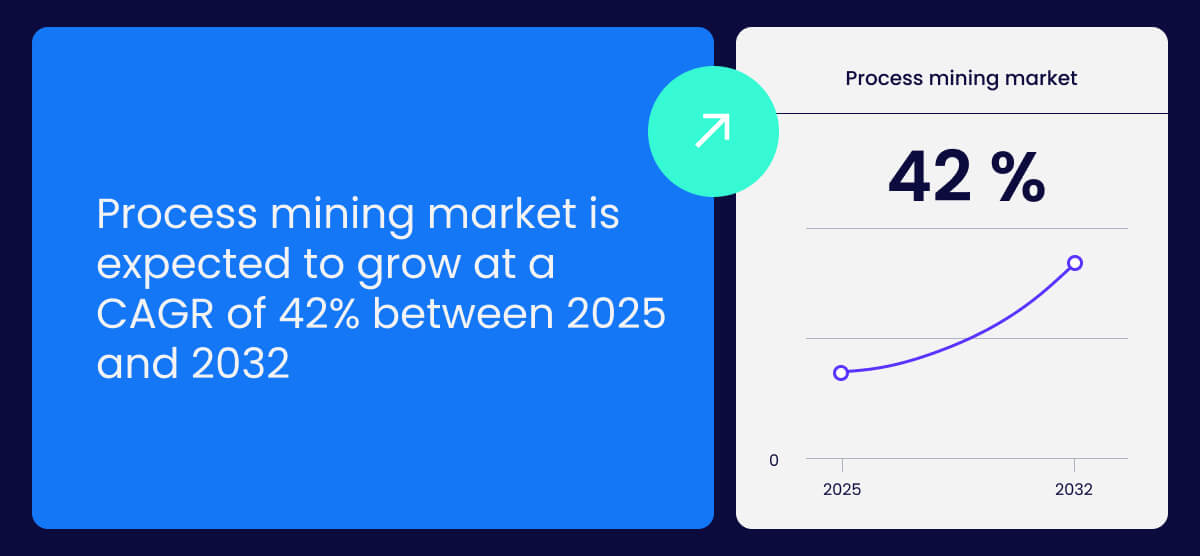What is process intelligence?
Process intelligence is the practice of gathering and analyzing data about how work flows through an organization to find problems and opportunities. It gives a true picture of what’s happening daily, not just what people think is happening

It closely connects with Business Process Management (BPM), which helps companies plan and improve their work processes. BPM often uses flowcharts and interviews, but process intelligence adds real data to the mix. That makes it easier to identify where plans don’t align with reality and what can be adjusted.
Various tools are available to action process intelligence. By connecting software such as Celonis or ABBYY Timeline to internal systems, teams can gain valuable insights that help them reduce waste, improve internal standards, and identify the best tasks to automate. This lays the groundwork for more advanced hyperautomation strategies.
How does process intelligence work?

Process intelligence reveals the true path of work across an organization. It collects data and analyzes how tasks are performed, providing insights that help teams to improve operations.
Instead of making assumptions about how a process works or guessing which improvements will be effective, decision-making can be backed up by data, making it truly data-driven. As a result, iterations on workflows become genuinely impactful.
Here’s how process intelligence works, from collecting data to implementing fixes.
Data collection
Data forms the foundation of process intelligence. Tools such as Celonis, UiPath Process Mining, ABBYY Timeline, and SAP Signavio Process Intelligence come into play, collecting information from the systems people use every day. These could include CRMs, financial tools, communication apps, desktop applications, or a combination thereof.
Every click, form submission, and system log entry becomes a data point, with tools using two key techniques during the process. One option is process mining, which pulls structured data from business systems to map how tasks flow from start to finish.
There is also task mining, which can capture user-level activity, such as keyboard strokes and on-screen interactions. Some businesses use both approaches to gain a full end-to-end picture, but sometimes only one is needed.
Once the tools have created a thorough understanding of how work happens in practice across tools and teams, they can begin analysis.
Process discovery and analysis
With the data now available, the tool can start to analyze how work flows through the organization. It will uncover all of the different ways a process is completed by using advanced process mapping, which shows each variation of a flow. For example, two workers may complete a process in different ways – and neither of them are the way senior management assumed it was being done.
The tool generates process maps that show each variation of a flow. It provides further detail, highlighting the steps that occur consistently and showcasing exceptions. After that, it can go deeper and identify any bottlenecks or delays that are slowing processes down.
With root cause analysis, the tool can dig deeper to explain why these issues are happening. Furthermore, with performance metrics, teams gain insight into how each step is performing in terms of speed and cost to the business.
Monitoring and conformance
Process intelligence tools build on their understanding and modelling of how workflows operate by monitoring them over time. They provide real-time insights and analysis, enabling teams to track changes and identify problems on an ongoing basis, rather than waiting for periodic reports.
They also provide conformance checking, in other words, comparing how processes actually work with how they are intended to operate. When a mismatch occurs, the system will flag it. Teams can then intervene, ensuring they can maintain internal standards or remain compliant.
Insights and decision-making
Businesses now have a full understanding of how work flows and where it breaks down. The tools at their disposal will not just indicate what goes wrong, but provide a priority order of what to fix and how to fix it. With this data-driven approach, workplaces can fulfil targeted business process reengineering efforts that will provide measurable results.
With predictive analytics, tools can look ahead to anticipate future problems using past data. For example, it may highlight potential risks of missed deadlines or overloaded resources. When teams use this feature in conjunction with benchmarking data and performance insights, they can concentrate on changes that will have the most significant impact.
Optimization and automation
Finally, insights are transformed into action. Businesses use everything they have learned to streamline their operations, which can involve tasks such as implementing business process automation (BPA) for repeatable patterns or making changes to underperforming steps in a process.
To support these actions, businesses can utilize simulation tools to test changes before they are implemented. Furthermore, KPI monitoring will track whether the improvements made are actually achieving the desired result. Overall, businesses engage in a culture of data-driven continuous improvement.
Process intelligence use cases

Process intelligence is gaining traction across various business sectors as organizations seek smarter ways to analyze and enhance the way work is done. That is why the process mining market is expected to grow at a CAGR of 42% between 2025 and 2032.

Manufacturing: Identifying production bottlenecks
In the manufacturing sector, factories frequently encounter production delays that are challenging to pinpoint without detailed insights. Process intelligence provides visibility into how products and tasks move through each stage of the production line.
For example, the tool may uncover hidden bottlenecks such as delays in routine maintenance that are impacting overall output. Armed with this information, teams can make targeted adjustments to improve efficiency.
Financial Services: Streamlining customer journeys
Financial institutions manage complex processes, such as customer onboarding and loan approvals, while also needing to remain compliant with stringent regulations. When there are delays or drop-offs, it’s often unclear what’s causing them.
Process intelligence tools provide a comprehensive view of these workflows, enabling the identification of issues such as slow identity verification. Once discovered, these hurdles can be addressed to streamline the process and boost customer conversion.
Retail & E-Commerce: Enhancing order fulfillment
Retailers and e-commerce companies frequently experience order fulfillment delays, particularly during peak demand periods, such as sales events. When customers complain, pinpointing the root cause can be challenging.
Process intelligence maps the journey from order to delivery, revealing issues such as poor integration between the e-commerce platform and inventory systems. With these insights, businesses can better align their systems, reduce shipping delays, and minimize customer complaints.